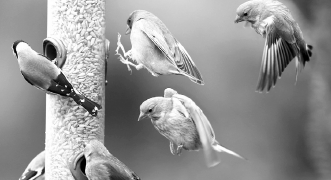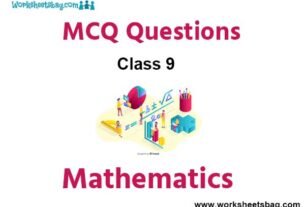Please refer to Surface areas and Volumes MCQ Questions Class 9 Mathematics below. These MCQ questions for Class 9 Mathematics with answers have been designed as per the latest NCERT, CBSE books, and syllabus issued for the current academic year. These objective questions for Surface areas and Volumes will help you to prepare for the exams and get more marks.
Surface areas and Volumes MCQ Questions Class 9 Mathematics
Please see solved MCQ Questions for Surface areas and Volumes in Class 9 Mathematics. All questions and answers have been prepared by expert faculty of standard 9 based on the latest examination guidelines.
MCQ Questions Class 9 Mathematics Surface areas and Volumes
Question. Find the radius of the base of a right circular cylinder whose curved surface area is 2/3 of the sum of the surface areas of two circular faces. The height of the cylinder is given to be 15 cm.
(a) 22 cm
(b) 22.5 cm
(c) 20 cm
(d) 20.5 cm
Answer
B
Question. If A, B and C are the areas of three adjacent faces of a cuboid, then its volume is
(a) ABC
(b) 2ABC
(c) √ABC
(d) A + B + C
Answer
C
Question. The side of a cube is 1 cm. The total surface area of the figure formed by joining two such cubes is
(a) 2(2 + 1 + 2) cm2
(b) 2(2 + 2 + 2) cm2
(c) 2(1 + 1 + 1) cm2
(d) 2(1 + 1 + 2) cm2
Answer
A
Question. If each side of a cube is increased by 50% , then the surface area of the cube increases by
(a) 50%
(b) 100%
(c) 125%
(d) 150%
Answer
C
Question. The lateral surface area of a cube of side 6 units is
(a) 144 sq. units
(b) 154 sq. units
(c) 134 sq. units
(d) 216 sq. units
Answer
A
Question. A tank measures 6 m × 5 m × 4 m. Its (2/3)rd portion is filled with water. The volume of water is
(a) 80 m3
(b) 60 m3
(c) 50 m3
(d) 40 m3
Answer
C
Question. The length of diagonal of cube is (14 × √3) cm. The volume of the cube is
(a) 2744 3√3 cm3
(b) 2744 cm3
(c) 588 cm3
(d) 3528 cm3
Answer
B
Question. If h, S and V denote respectively the height, curved surface area and volume of a right circular cone, then 3πVh3 – S2h2 + 9V2 is equal to
(a) 8
(b) 0
(c) 4π
(d) 32π2
Answer
B
Question. The total surface area of a cuboid of dimensions x units, y units and z units is _______ sq. units.
(a) 4{xy + yz + zx}
(b) 2{xy + yz + zx}
(c) 3{xy + yz + zx}
(d) none of these
Answer
B
Question. If the total surface area of a cylinder is 550 cm2 and its base circumference is 50 cm, then the sum of its height and radius is
(a) 11 cm
(b) 50 cm
(c) 45 cm
(d) 55 cm
Answer
A
Question. If the areas of the adjacent faces of a rectangular block are in the ratio 2 : 3 : 4 and its volume is 9000 cm3, then the length of the shortest edge is
(a) 30 cm
(b) 20 cm
(c) 15 cm
(d) 10 cm
Answer
C
Question. The curved surface area of the cone of slant height x/2 is 2πx. Then area of its base is
(a) 4π sq. units
(b) 4πx2 sq. units
(c) πx2 sq. units
(d) 16π sq. units
Answer
D
Question. The diameter of a sphere is decreased by 25%. By what percentage its volume will decrease?
(a) 25%
(b) 57.81%
(c) 43.50%
(d) 50%
Answer
B
Question. A cone, a hemisphere and a cylinder stand on equal bases and have the same height. The ratio of their volumes is
(a) 1 : 2 : 3
(b) 2 : 1 : 3
(c) 2 : 3 : 1
(d) 3 : 2 : 1
Answer
A
Question. The radius of a wire is decreased by onethird. The volume remains same, if the length will increase
(a) 3 times
(b) 6 times
(c) 9 times
(d) 27 times
Answer
C
Assertion & Reasoning Based MCQs
(a) Assertion and Reason both are correct statements and Reason is the correct explanation of Assertion.
(b) Assertion and Reason both are correct statements but Reason is not the correct explanation of Assertion.
(c) Assertion is correct statement but Reason is wrong statement.
(d) Assertion is wrong statement but Reason is correct statement.
Question. Assertion : A cone is a solid figure.
Reason : A cone is generated when rectangular sheet is rotated about its axis.
Answer
C
Question. Assertion : The external dimensions of a wooden box are 18 cm, 10 cm and 6 cm respectively and thickness of the wood is 5 mm, then the internal volume is 765 cm3.
Reason : If external dimensions of a rectangular box be l, b and h and the thickness of its sides be x, then its internal volume is (l – 2x)(b – 2x)(h – 2x).
Answer
A
Question. Assertion : If curved surface area of a cone is 550 cm2 and its diameter is 14 cm. Then, its slant height will be 20 cm.
Reason : Curved surface area of a cone having base radius r and slant height l is πrl.
Answer
D
Question. Assertion : If a cone and a hemisphere have equal base and volume, then the ratio of their heights is 2 : 1.
Reason : Volume of a cylinder of height h and base radius r is πr2h.
Answer
B
Question. Assertion : If the radius of a sphere is tripled, then the ratio of the volume of the original sphere to that of the new is 1 : 27.
Reason : Volume of a sphere with radius r is 4πr3.
Answer
C
Case Based MCQs
Read the following passage and answer the questions
Ankita realised the need of food for birds on her terrace and decided to make a bird feeder. She got a flexible plastic rectangular sheet of size 44 cm × 15 cm. She rolled it along its length and joined the two opposite ends using a tape for circular base of cylinder. She found a square sheet of size 15 cm × 15 cm by cutting it into required circular shape she prepared the bird feeder as shown in figure.


Question. The curved surface area of the cylinder formed is
(a) 550 cm2
(b) 660 cm2
(c) 430 cm2
(d) 840 cm2
Answer
B
Question. How much will be the area of square sheet left unused after removing the circular base of the cylinder from it?
(a) 78 cm2
(b) 62 cm2
(c) 75 cm2
(d) 71 cm2
Answer
D
Question. Volume of the seeds that can be filled in the cylinder, for birds is
(a) 2310 cm3
(b) 2425 cm3
(c) 2623 cm3
(d) 2810 cm3
Answer
A
Question. The radius of the base of the cylinder is
(a) 5 cm
(b) 6 cm
(c) 7 cm
(d) 8 cm
Answer
C
Question. The area of the circular base required for the cylinder is
(a) 154 cm2
(b) 164 cm2
(c) 240 cm2
(d) 184 cm2
Answer
A
Read the following passage and answer the questions
Nakul was doing an experiment to find the radius r of a ball. For this he took a cylindrical container with radius R = 7 cm and height 10 cm. He filled the container almost half by water as shown in the figure-1. Now he dropped the ball into the container as in figure-2. He observed that in figure-2, the water level in the container raised from P to Q i.e, to 3.4 cm.

Question. How many litres of water can be filled in the full container ?
(a) 1.54 litres
(b) 2 litres
(c) 5 litres
(d) 7.5 litres
Answer
A
Question. What is the approximate radius of the ball?
(a) 3 cm
(b) 5 cm
(c) 7 cm
(d) 9 cm
Answer
B
Question. What is the total surface area of the spherical ball?
(a) 441.34 cm2
(b) 314.29 cm2
(c) 620 cm2
(d) 816 cm2
Answer
B
Question. What is the volume of the cylinder?
(a) 1260 cm2
(b) 540 cm3
(c) 1620 cm3
(d) 1540 cm3
Answer
D
Question. What is the volume of the spherical ball?
(a) 620 cm3
(b) 824.26 cm3
(c) 523.81 cm3
(d) 430.1 cm3
Answer
C
